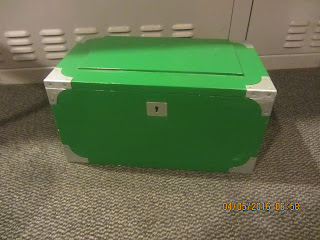It is a little more that a year ago since I finished the green
tool chest that I bring with me on the ship.
I have brought it back and forth in my bag/suitcase every time I
signed on and signed off.
So I feel that I am able to give an honest review of this type of
tool chest if anyone feel the need to make a small chest to accompany them on
their travels.
My tool chest measures 16" x 9.5" x 8.25" (length x
width x height), so it will not fit very large tool inside.
The corner reinforcements were made out of some old sheet metal that
we had lying around. They have succeeded in keeping the chest free from damage
despite it being thrown around by baggage handlers in various airports. In
addition to that, I also think they look good.
The bottom is the weakest link in the tool chest. I wanted a clean
look of the outside of the chest, so the bottom was simply nailed on inside a
rebate. I never added any nails from the outside, but so far I have only
noticed one or two nails starting to creep out, but a light tap of a hammer
brought them back in. So unless i load it with lead ingots, I suppose it will
be fine.
I really like the two tills that sit in the top of the chest. The
smaller one was originally intended for a pencil, but it has been filled with
hinges, screws, nails and locks instead.
The larger till is sufficiently large to accommodate my three
chisels plus stuff like my oil stone and the marking gauge.
The shooting board doesn't see much use, but that is because I
have taken a fancy in making stuff with sloping corners and other shapes. But
when I need a shooting board it is nice to have.
The lower part of the chest which is the main room has got just
enough space for my plane and the two irons for it. A mallet, a small dozuki, a
grooving plane and a moving filister plane. Until a week ago there was also a
small jar of glue that had survived almost two years of travelling before
finally giving up.
As it can be seen, there are no lifts on the chest. I really don't
think they are necessary given the small size of the chest itself. It is so
easy to just wrap an arm around the chest and carry it around. I think that
while lifts can look fine they would distract from the clean look on this
chest. they would also add some weight which is not a good thing for airline
travel.
Totally I think the chest including contents weighs something like
26 Lbs.
For a travelling tool chest that needs to handle all the tools you
really need, you would probably have to make it a wee bit larger. That would be
to accommodate a larger saw and a hammer. Those tools I normally borrow from
the ships workshop, so I don't really need to bring them myself.
A solution to the saw could be a frame saw that can be taken
apart, and having one crosscut blade and one ripping blade.
I haven't been stopped by custom officers yet and had to explain
the tool chest to them, but I suppose it should be OK.
If you travel between countries that have strict regulations concerning
bringing items made out of wood across the border, it might be best to tick off
that box on the declaration board and avoid getting into trouble for forgetting
it.
The little I know about wood products crossing borders, is that
they tend to be mostly concerned if the bark is still on the wood. Or if the
wood is attacked by insects.
Green travelling tool chest.
Lid open.












